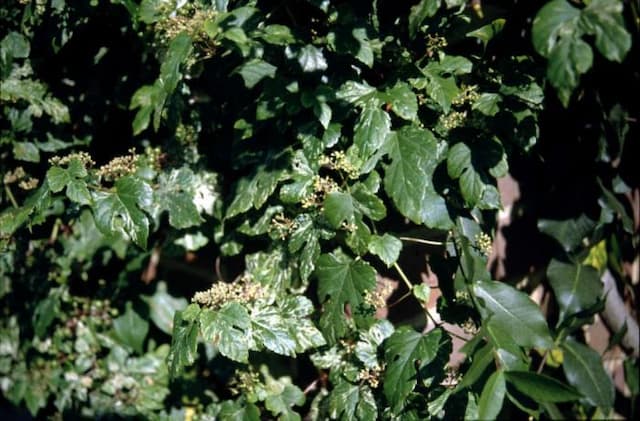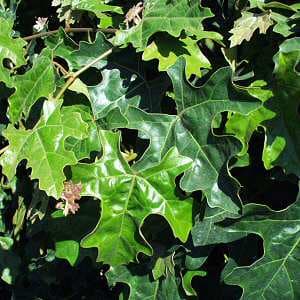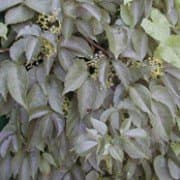Ivy of Uruguay Cissus striata

ABOUT
Cissus striata, commonly known as Miniature Grape Ivy, is a climbing or trailing vine. This plant is characterized by its attractive foliage. It has leaves that are green and glossy, with a slightly leathery texture. Each leaf is composed of three leaflets that have a smooth margin and an oval to lance-shaped appearance. The veins are often a lighter green and create a distinctive striated or striped pattern on the leaf surface, which can be quite ornamental. The Miniature Grape Ivy produces small clusters of yellowish-green flowers, but these are typically not very showy and can go unnoticed. Following the flowers, it may produce small, non-edible berries that turn from green to a dark color as they mature. The vine has tendrils which it uses to climb and attach to various supports or structures. These tendrils give the vine the ability to cover surfaces and can create a lush, green curtain of foliage when provided with a suitable climbing frame. The overall appearance of the plant is one of dense greenery, making it a popular choice for creating green walls or for use in hanging baskets where it can cascade attractively over the sides.
About this plant
 Names
NamesSynonyms
Miniature Grape Ivy, Ivy Of Uruguay, Vicks Plant, Grape Ivy
Common names
Cissus antarctica, Cissus striata var. argentina, Vitis striata, Cissus ovata.
 Toxicity
ToxicityTo humans
Cissus striata, commonly known as mini grape ivy, is not widely recognized as a toxic plant to humans. There are no significant reports or studies indicating that mini grape ivy poses serious risks if ingested. However, as with any plant, individuals may have varying levels of sensitivity, and it is possible to experience digestive discomfort or an allergic reaction if the plant is ingested. Such symptoms, if they occur, might include mild nausea, vomiting, or diarrhea. Always exercise caution and keep plants out of reach of young children who might inadvertently consume plant parts.
To pets
Mini grape ivy is not commonly listed as a toxic plant to pets such as dogs and cats. While it is not associated with severe toxicity, ingestion of the plant might lead to mild gastrointestinal upset in some pets. Symptoms could include vomiting, diarrhea, or lack of appetite if pets consume large amounts of the plant. It is always a good practice to monitor pets around houseplants and discourage them from chewing on plants to prevent any potential digestive discomfort. If you suspect your pet has eaten a substantial amount of mini grape ivy, or if they display symptoms of illness, contacting a veterinarian would be advisable.
 Characteristics
CharacteristicsLife cycle
Perennials
Foliage type
Evergreen
Color of leaves
Green
Height
10 feet (3 meters)
Spread
6 feet (1.8 meters)
Plant type
Climber
Hardiness zones
9
Native area
South America
Benefits
 General Benefits
General Benefits- Ornamental appeal: Cissus striata, commonly known as Ivy of Uruguay, features attractive foliage, which can enhance the aesthetic value of gardens and indoor spaces.
- Drought tolerance: It is relatively drought-tolerant, making it suitable for xeriscaping and for gardeners in areas with water restrictions or those looking to conserve water.
- Easy propagation: Ivy of Uruguay can be easily propagated through stem cuttings, which allows for rapid and cost-effective multiplication of the plant.
- Low maintenance: It requires minimal care, making it a good choice for both inexperienced gardeners and those with limited time to dedicate to plant care.
- Versatility: The plant can be used in various landscaping applications, such as ground cover, climbing walls, or trailing from hanging baskets.
- Erosion control: Its ability to spread rapidly and form dense mats makes it useful for stabilizing slopes and preventing soil erosion.
- Rapid growth: Cissus striata grows quickly, providing swift coverage and filling in garden areas that need immediate attention.
- Wildlife habitat: Although not its primary purpose, it can provide shelter and food for certain species of insects and birds.
 Medical Properties
Medical Properties- Anti-inflammatory: Cissus striata may help reduce inflammation in the body.
- Antioxidant: The plant possesses antioxidant properties that could help in protecting the body against oxidative stress.
- Analgesic: It may have pain-relieving properties, helping to alleviate discomfort.
- Antimicrobial: Cissus striata might have the ability to combat certain microbes, contributing to its use in preventing or treating infections.
- Healing properties: It's traditionally used to promote wound healing and support the treatment of broken bones.
 Air-purifying Qualities
Air-purifying QualitiesThis plant is not specifically known for air purifying qualities.
 Other Uses
Other Uses- Cissus striata can be used as a natural adhesive due to its sticky sap when cut or damaged, which may be suitable for minor repairs or as a binding agent in traditional crafts.
- The vines of the Miniature Grape Ivy can be woven into small baskets, mats, or even decorative items, capitalizing on its durability and flexibility.
- Cultivated as a ground cover, Miniature Grape Ivy can help prevent soil erosion in gardens due to its dense and spreading growth habit.
- The plant can be used in horticultural therapy programs, where its easy-care nature makes it suitable for engaging individuals in gardening activities, promoting well-being and relaxation.
- Miniature Grape Ivy's dense foliage can provide a natural screen for privacy in gardens or on patios when grown along trellises or fences.
- The leaves of Miniature Grape Ivy can sometimes be used as a natural green dye for fabrics, though this is not a widespread practice.
- In educational settings, the plant can be used to teach principles of botany and plant care, as it is a robust specimen with visible leaf venation and climbing habits.
- As a component in terrariums or miniature gardens, Miniature Grape Ivy adds a lush, trailing element that can mimic the look of larger vines in a compact space.
- During seasonal festivities, the vines can be used to create natural decorations, such as wreaths or table runners, lending a rustic and earthy touch to the decor.
- The resilient nature of Miniature Grape Ivy allows it to be used in urban greening projects, contributing to the aesthetic enhancement and biodiversity of urban areas.
Interesting Facts
 Feng Shui
Feng ShuiThe Miniature Grape Ivy is not used in Feng Shui practice.
 Zodiac Sign Compitability
Zodiac Sign CompitabilityThe Miniature Grape Ivy is not used in astrology practice.
 Plant Symbolism
Plant Symbolism- Resilience: Cissus striata, commonly known as Ivy of Uruguay, often symbolizes resilience due to its climbing nature and ability to adapt to various environments, clinging and thriving on a wide range of surfaces.
- Growth and Expansion: Its vigorous growth habit represents the idea of expansion and reaching outwards, suggesting personal or spiritual growth.
- Protection: The dense foliage of the Ivy of Uruguay can offer shelter and camouflage, translating to a symbolic meaning of protection and safe haven.
- Fidelity: As a plant that clings steadfastly to a structure or tree, it can symbolize faithfulness and enduring attachments, much like traditional ivy symbolism.
 Water
WaterThe Miniature Grape Ivy prefers to be watered when the top inch of soil has dried out, usually about once a week. Use room temperature water to avoid shocking the plant's roots. When watering, provide enough water to moisten the soil evenly without waterlogging it; this may equate to approximately one gallon for a medium-sized pot over a month, depending on the plant's size and environmental conditions. Always adjust the frequency and amount of water based on the humidity, temperature, and light conditions, as well as the plant's growth phase.
 Light
LightMiniature Grape Ivy thrives in bright, indirect light but can also adapt to medium light conditions. A spot near a north or east-facing window offers ideal lighting, and if placed in a south or west-facing location, it should be protected with a sheer curtain to diffuse intense direct sun which can damage the leaves.
 Temperature
TemperatureMiniature Grape Ivy is comfortable in a temperature range between 60 to 80°F. It can tolerate a minimum temperature of 50°F, but should not be exposed to temperatures below this as it may lead to stress and potential damage. The ideal temperature for robust growth is within the 60 to 80°F range.
 Pruning
PruningMiniature Grape Ivy may require pruning to maintain its shape, encourage bushier growth, or remove any dead or damaged foliage. Pruning is best done in spring or early summer when the plant is actively growing. Snip the stems just above a leaf node, and you can prune it every few months as needed to control its growth or encourage a desired form.
 Cleaning
CleaningAs needed
 Soil
SoilFor the Miniature Grape Ivy, a well-draining potting mix is best. Combine two parts of peat moss with one part perlite or coarse sand to enhance drainage. This plant prefers a slightly acidic to neutral pH, around 6.0 to 7.0, for optimal growth.
 Repotting
RepottingMiniature Grape Ivy should be repotted every 2 to 3 years, or when it becomes root-bound. To check if it's time to repot, look for roots growing through the drainage holes or soil that dries out quickly after watering.
 Humidity & Misting
Humidity & MistingMiniature Grape Ivy thrives in moderate to high humidity levels. Aim to maintain around 40-50% relative humidity for this plant to flourish.
 Suitable locations
Suitable locationsIndoor
Place Miniature Grape Ivy in bright, indirect light with some humidity.
Outdoor
Grow Miniature Grape Ivy in shade to partial sun, protect from strong winds.
Hardiness zone
9-11 USDA
 Life cycle
Life cycleCissus striata, commonly known as Ivy of the South, begins its life cycle as a seed, dispersed in the wild by birds or other animals. Germination occurs when conditions are warm and moist, leading to the emergence of a radicle and plumule that develop into the plant's root system and initial shoots respectively. As a fast-growing vine, it enters a vegetative stage where it produces stems that climb or sprawl, along with leaves for photosynthesis; it may also propagate vegetatively through cuttings. After reaching maturity, Ivy of the South produces clusters of small, greenish flowers, generally inconspicuous and followed by berry-like fruits that mature to black. These fruits contain seeds that, once mature, are ready to be dispersed, completing the reproductive cycle. The plant can live for many years, growing and spreading continuously if conditions are favorable, going through multiple cycles of flowering and fruiting.
 Propogation
PropogationPropogation time
Spring-Early Summer
The most popular method of propagation for Cissus striata, commonly known as Ivy of Uruguay, is through stem cuttings. This is ideally done in spring or early summer when the plant is actively growing. To propagate, a healthy stem cutting approximately 4 to 6 inches (about 10 to 15 centimeters) long with several leaves is selected. The bottom set of leaves is removed, and the cut end can be dipped in rooting hormone powder to encourage root growth, though this is not strictly necessary. The cutting is then planted in a well-draining soil mix, and kept moist but not waterlogged. Placing the pot in a warm spot with indirect light can improve the chances of successful rooting. New growth typically indicates that the cutting has successfully rooted, after which it can continue to be cared for like a mature plant.








![Grape [Claret Cloak]](/_next/image?url=https%3A%2F%2Fplants-admin.emdemapps.com%2Fimages%2Fplants%2F%2Fimages%2F604b602abe2f8.png&w=640&q=75)
